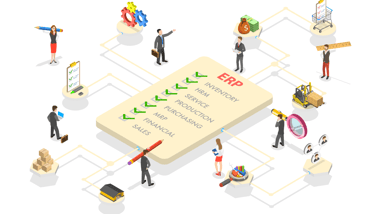.webp?width=450&name=Image20211217104534%20(1).webp) Organizations everywhere are looking to take charge of their future by using data to back up their decisions and plan more strategically. Finance leaders can overcome the uncertainty of today’s political and economic climate by using data as a rudder in the storm. The balance sheet, a key financial statement, provides essential information about the future total financial position of the organization. It is your road map to decipher how value is created with every dollar earned and spent. Its uses are often sequestered to external reporting since it can be difficult to plan the balance sheet at the level of granularity needed for internal decision making but this can be overcome. The balance sheet can become a key tool within the office of finance if an organization rises to the challenge of using minimal resources to create a usable, forecasted balance sheet.
Organizations everywhere are looking to take charge of their future by using data to back up their decisions and plan more strategically. Finance leaders can overcome the uncertainty of today’s political and economic climate by using data as a rudder in the storm. The balance sheet, a key financial statement, provides essential information about the future total financial position of the organization. It is your road map to decipher how value is created with every dollar earned and spent. Its uses are often sequestered to external reporting since it can be difficult to plan the balance sheet at the level of granularity needed for internal decision making but this can be overcome. The balance sheet can become a key tool within the office of finance if an organization rises to the challenge of using minimal resources to create a usable, forecasted balance sheet.
Typically, the challenges associated with creating projected balance sheets leave finance teams questioning its utility. Common issues encountered in traditional FP&A for balance sheet forecasting include siloed data, poor communication between departments, and difficult data aggregations while an immensely manual process required for data consolidation complicates these issues further.
What are the Issues with Data Silos?
Organizational data can be stored in difficult-to-access formats and locations (silos) that create headaches when trying to perform holistic financial processes like balance sheet forecasting. All organizations struggle to manage the plethora of information throughout their financial processes, organizing and storing this data is challenging, cannibalizes time, and ultimately shifts the focus of finance teams to being data stewards rather than analyzing business performance and strategy.
Why Inter-Departmental Communication is Important for Finance Teams
More issues may occur when various departments work with conflicting datasets which in turn create cascading issues of confidence in projections. Balance sheet projections are only as valuable as the accuracy of the planning process and the quality of the data being consolidated by that process. The lack of data governance and automation has long been a weakness of traditional FP&A and is the area in which modern planning tools have the most immediate impact on businesses.
How Poor Data Structuring Hinders Financial Processes
One of the largest issues organizations face when performing balance sheet forecasting or indeed any FP&A process is the aggregation and disaggregation of data. Movement between accounts, the effect of a new capital project, or changes to cash management strategy can be painstakingly difficult to track. Now, imagine you need to roll up information or drill down through your organizational, departmental, or regional hierarchy and the idea of forecasting again becomes a burden that is sure to require much of your team’s valuable time. Data aggregation through OLAP modeled hierarchies allows finance teams to quickly filter through the noise, lift the layers of consolidated data and gain insights to solve key business questions. Ultimately empowering finance teams to use performance-driven analysis and identify areas of strategic opportunity. Planning processes that live in Excel create enormous opportunities for errors, inefficiency, and multiple versions of the truth.
The Value of Modern FP&A
The competitive landscape has changed, making transparency, availability, and confidence in data critical to a modern performance-oriented company. The ability to pivot and make decisions in real-time greatly improves the outcome of how you navigate financial and operational challenges. Companies that have invested in modernizing their FP&A functions now have data at their fingertips, that is not only trustworthy but also incredibly detailed without having spent days every month jockeying reports, performing data health checks, and correcting broken formulas and reference errors. Now that the focus of finance teams can shift from the manual maintenance of spreadsheets, highly technical team members can begin focusing on initiatives to make finance teams true business partners within the organization.
Balance sheet forecasting completes an organization’s financial self-portrait. It’s useful in a variety of business cases such as shareholder reporting, planning for large capital projects, and debt covenant compliance. Roadblocks arising from data collection and communication issues can easily be overcome with technology automating a great deal of the processes that usually cause headaches for finance teams and executives alike. Removing those headaches enables an organization to think strategically about its future, using data to its full potential for planning and analysis.
A Tailored Solution
Fortunately, technology has advanced to provide solutions to challenges that have littered traditional FP&A processes for decades. Cloud-based FP&A programs like Limelight, automate the collection of data by directly integrating with an organization’s ERP software and other disparate data sources, centralizing the planning process. Finance teams no longer have to spend hours sifting through Excel files, looking for data, and wondering if the information is trustworthy. Because modern planning tools like Limelight create a single source of truth in the organization, communication is greatly improved between different departments. The end result is transparency, a culture of collaborative planning, and more time available for strategic evaluation of business performance among teams.






